Creating your own perfume is a beautiful way to express your individuality. With the right blend of fragrance oils, essential oils, and a high-quality perfume solvent, you can craft scents that are long-lasting, balanced, and uniquely yours.
At Holistic Emporium, we believe perfume-making should be fun, creative, and accessible to everyone. That’s why we’ve created this Free Perfume Ratio Guide – to help you learn the art of perfume blending with clear percentages and ml measurements.
Why Perfume Ratios Matter
When blending perfumes, ratios are everything. The strength, longevity, and character of your fragrance depend on how much fragrance oil you add compared to the perfume solvent. Too much oil can make a perfume overpowering, while too little may cause the scent to fade quickly.
By following tried-and-tested ratios, you’ll achieve a professional-quality finish – whether you’re making a light body splash or a luxurious parfum.
Perfume Blending Ratios (in ml per 100 ml finished product)
Here’s your go-to guide for perfume concentrations:
1. Eau de Cologne (Fresh & Light)
- Fragrance oils/essential oils: 2–5 ml
- Perfume solvent: 95–98 ml
✔ Best for daytime wear, light and refreshing scents.
2. Eau de Toilette (Everyday Wear)
- Fragrance oils/essential oils: 5–15 ml
- Perfume solvent: 85–95 ml
✔ Popular strength for commercial perfumes.
3. Eau de Parfum (Rich & Long-Lasting)
- Fragrance oils/essential oils: 15–20 ml
- Perfume solvent: 80–85 ml
✔ Perfect balance between strength and elegance.
4. Extrait de Parfum / Parfum (Luxury Concentration)
- Fragrance oils/essential oils: 20–30 ml
- Perfume solvent: 70–80 ml
✔ Strong, opulent, and designed for luxury perfume lines.
💡 Scaling Tip: To make a 1-litre batch, multiply all measurements by 10.
Don’t Forget About Maceration
Once your perfume is blended, it needs time to mature – this process is called maceration. Think of it like ageing wine: resting the perfume allows the fragrance oils, solvent, fixatives, and UV stabilisers to fully bind together.
How to Macerate Your Perfume:
- Store in a glass bottle (amber is best).
- Keep in a cool, dark place away from sunlight.
- Leave for 2–6 weeks.
- Gently shake once a week.
The result? A smoother, richer, and more long-lasting fragrance.
Why Use Holistic Emporium’s Advanced Perfume Solvent Formula?
Not all solvents are created equal. Our Advanced Perfume Solvent Formula is specially designed for luxury perfume lines, offering:
- UV protection (perfect for coastal areas).
- Built-in fixatives for longer-lasting scent trails.
- Seamless blending with Perfume oils.
- No license required – safe and ready to use.
This makes it the perfect base for both DIY enthusiasts and professional perfumers.
Free Download: Perfume Ratio Guide
Want to keep these ratios handy? Download our Free Perfume Ratio Guide and start blending like a professional. Whether you’re creating a signature scent for yourself or formulating for a brand, this guide will help you achieve perfect results every time.
👉 [Download Your Free Perfume Ratio Guide Here]
Final Tips for DIY Perfumers
- Always start small – test with 10–20 ml batches before scaling up.
- Keep a perfume journal with your exact ratios, notes, and maceration times.
- Experiment with top, middle, and base notes for depth and complexity.
- Patience pays off – never skip the maceration step.
Holistic Emporium – Your Partner in Perfume Making
From essential oils to perfume solvents, fragrance oils, and packaging, we supply everything you need to create perfumes that are natural, long-lasting, and professional quality. Explore our range at www.holisticemporium.co.za and start your perfume-making journey today.



